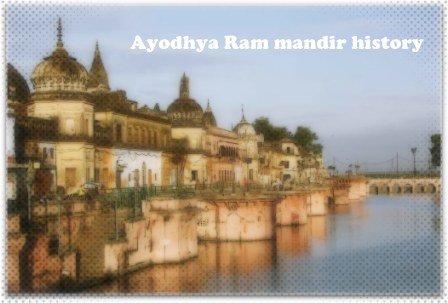Dharm
Ayodhya Ram mandir history

- 1528: Babur built a mosque here called Babri Masjid. According to Hindu belief, Lord Rama was born at this place.
- 1853: Hindus allege that mosque was built by demolishing Lord Rama’s temple. The first violence took place between Hindus and Muslims over the issue.
- 1859: The British government erects a barbed wire and allows separate prayers to Muslims and Hindus in the inner and outer premises of the disputed land.
- 1885: The case first reached court. Mahant Raghubar Das filed an appeal in the Faizabad court for permission to build a Ram temple adjoining the Babri Masjid.
- 23 December 1949: Around 50 Hindus reportedly placed a statue of Lord Rama at the central site of the mosque. And Hindus started worshiping regularly. Muslims stopped offering Namaz.
- 16 January 1950: Gopal Singh Visharad seeks special permission to worship Ramlala in Faizabad court by filing an appeal.
- 5 December 1950: Mahant Paramahamsa Ramchandra Das sues to continue Hindu prayers and keep Ramamurthy in Babri Masjid. The mosque was named ‘Dharka’.
- 17 December 1959: Nirmohi Akhara files suit for transfer of disputed site.
- December 18, 1961: Uttar Pradesh Sunni Waqf Board files suit for ownership of Babri Masjid.
- 1984: The Vishwa Hindu Parishad (VHP) started a campaign to open the locks of Babri Masjid and make Ram Janmasthan independent and build a huge temple. A committee was formed.
- February 1, 1986: Faizabad District Judge allows Hindus to worship at the disputed site. The locks were reopened. The Muslims formed the Babri Masjid Action Committee.
- June 1989: The Bharatiya Janata Party (BJP) started giving formal support to the VHP, giving new life to the temple movement.
- 1 July 1989: A fifth lawsuit was filed.
- 9 November 1989: The government of the then Prime Minister Rajiv Gandhi allowed the foundation stone near Babri Masjid.
- 25 September 1990: BJP President LK Advani took out a rath yatra from Somnath in Gujarat to Ayodhya in Uttar Pradesh, which was followed by communal riots.
- November 1990: Advani is arrested in Samastipur, Bihar. The BJP then appointed Prime Minister V.P. Withdrew support from Singh’s government.
- October 1991: Kalyan Singh government in Uttar Pradesh took over 2.77 acres of land around Babri Masjid.
- December 6, 1992: Thousands of Kar Sevaks demolish Babri Masjid after reaching Ayodhya. This was followed by communal riots. A temporary Ram temple was built in haste.
- 16 December 1992: The Liberhan Commission is formed to investigate the responsible conditions for the demolition of the mosque.
- January 2002: Prime Minister Atal Bihari Vajpayee started an Ayodhya department in his office, whose job was to negotiate with Hindus and Muslims to resolve the dispute.
- April 2002: A three-judge bench begins hearing on the ownership of the disputed site in Ayodhya.
- March-August 2003: Archaeological Survey of India excavated in Ayodhya on the instructions of Allahabad High Court. The Archaeological Survey of India claimed that there was evidence of the remains of the temple under the mosque. There were different opinions among Muslims about this.
- September 2003: A court ruled that seven Hindu leaders instigating the demolition of the mosque be called for trial.
- July 2009: The Liberhan Commission submitted its report to Prime Minister Manmohan Singh 17 years after its formation.
- 28 September 2010: The Supreme Court paved the way for the judgment, dismissing the petition preventing the Allahabad High Court from awarding the disputed case.
- September 30, 2010: Lucknow bench of Allahabad High Court gives historic verdict. The Allahabad High Court divided the disputed land into three parts, one part in the Ram temple, the other in the Sunni Waqf Board and the Nirmohi Akhara.
- May 9, 2011: The Supreme Court stayed the Allahabad High Court verdict.
- July 2016: Death of Hashim Ansari, the oldest litigant in the Babri case.
- March 21, 2017: Supreme Court speaks of resolving the dispute by mutual consent.
- April 19, 2017: Supreme Court orders criminal cases against many leaders of BJP and RSS including LK Advani, Murali Manohar Joshi, Uma Bharti in the Babri Masjid demolition case.